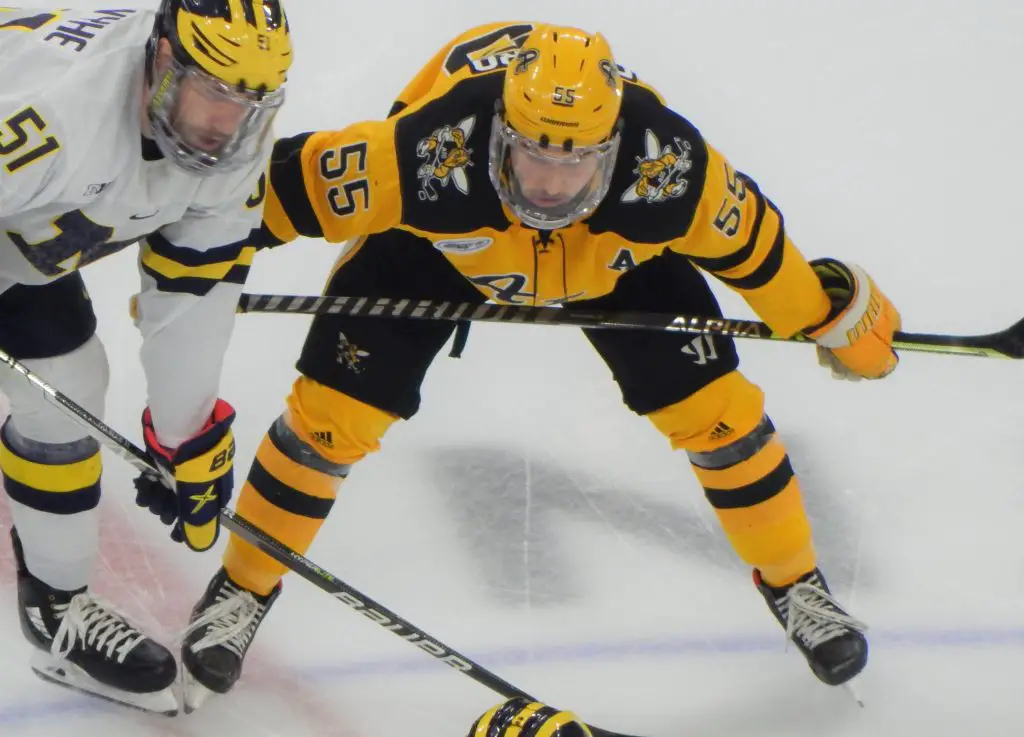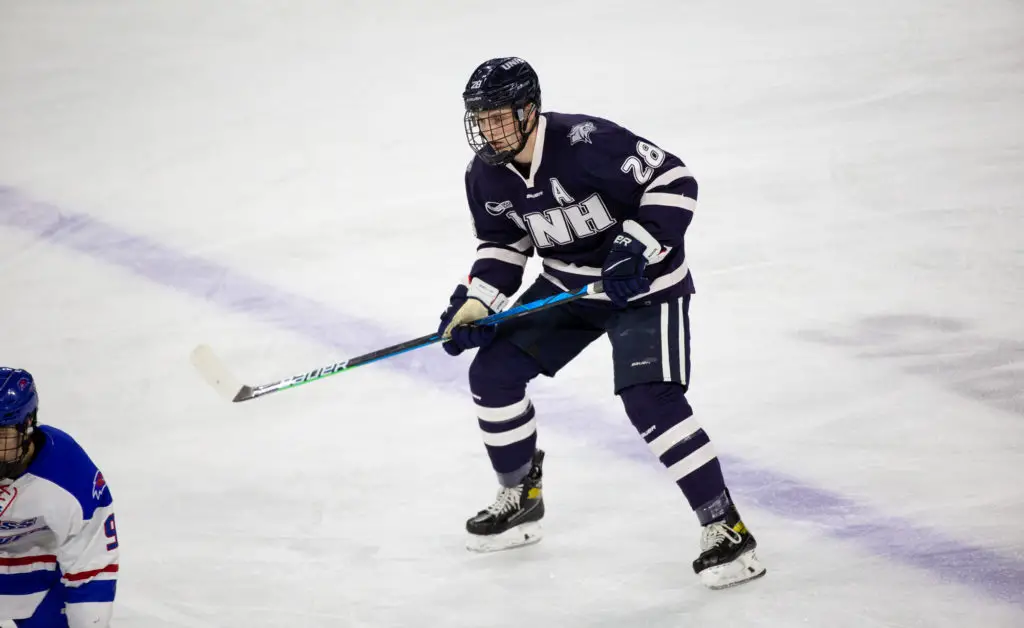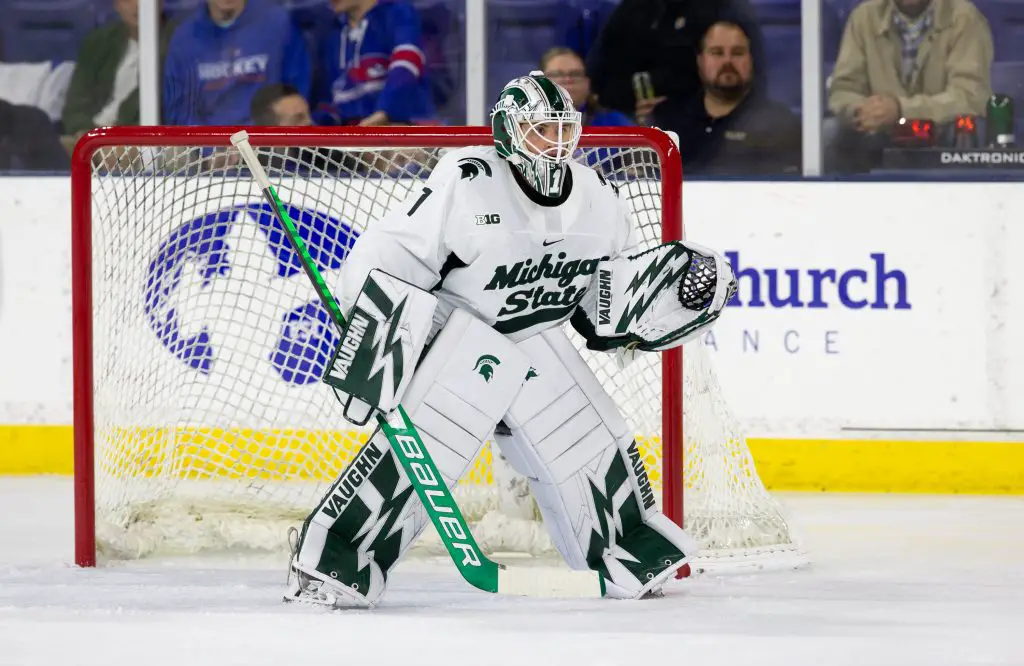
The transfer portal is akin to the intercollegiate athletics version of free agency — more so now than ever — with the NCAA relaxing its transfer rules last year, at least where ice hockey was concerned.
Previously, student-athletes in most NCAA sports who transferred to a new school were required to sit out a full year of competition before they were eligible to play. Now, they are permitted a one-time transfer where they can suit up immediately for their new institution.
“Once they’re in, it works both ways,” said Arizona State coach Greg Powers of the portal, and about who contacts whom. “Kids are reaching out to us all the time, looking for homes.”
The Sun Devils had two graduate transfers this past season in forwards Jack Becker (Michigan) and Colin Theisen (Notre Dame), whom he said “worked out well.” ASU also brought back a number of homegrown fifth-year seniors for 2021-22, such as Arizona native Johnny Walker, after it played all of its games on the road in 2020-21 due to the coronavirus pandemic.
“We wanted to give them a normal year, and it was the right thing to do,” said Powers, whose team will finally move into a brand-new on-campus rink this fall.
Reasons for student-athletes transferring can vary. Many desire more playing time than they are getting at their original school, while some may just want a change of scenery. Others were forced to move on elsewhere after schools like Alabama Huntsville, Alaska Anchorage and Robert Morris suspended play in recent years.
Further compounding roster construction and recruiting was the 2019-20 NCAA season, where COVID-19 canceled all college winter sports championships that year, including the Frozen Fours. The NCAA retroactively granted student-athletes who had played that season an unprecedented extra year of eligibility they wouldn’t have had otherwise, except for perhaps medical redshirt reasons, thus opening the doors for fifth-year graduate transfers. That fifth-year phenomenon will last for two more years, for this upcoming season’s juniors and seniors.
One prominent example is Cameron Wright, who played four years at forward for Bowling Green. He left BGSU after the 2020-21 season, with 51 total goals to his credit, but still had the one additional year left to play in college, thanks to COVID.
“There were many guys, seniors, who thought of moving on,” he said of his time with the Falcons. “We didn’t get the pro recognition (we anticipated), and after a conversation we had, we thought maybe we should go somewhere else.”
Wright and the BGSU coaching staff subsequently made a mutual decision to allow him to move on, and he entered the transfer portal. Denver was on his list of possible schools, but he didn’t hear back from the Pioneers for almost a month.
“They did their due diligence,” he related. “I got the opportunity to go to DU, and it was the right choice.”
Wright played in all 41 games last season and scored the final one of his 74 collegiate goals into an empty net to seal DU’s 5-1 win over Minnesota State in the NCAA title game. He also tied for the team lead with 23 goals, while finishing his career with 185 total games played.

Similarly, Benton Maass played four years on the blue line at New Hampshire, then helped Minnesota State get back to the Frozen Four last year as he concluded his career with 162 appearances in all.
Players aren’t necessarily finished now with college hockey after they obtain their bachelor’s degree. Transfers can get to work on a master’s degree or certificate, and potentially complete it in one year’s time, on someone else’s dime. Wright, who earned his bachelor’s degree in sports management at BGSU, labored on a master’s certificate in marketing communications while at DU.
Michael Karow actually made the NCAA tournament the past two years with different schools. In 2021 it was with Boston College, where Karow played in 131 games on defense over four seasons. This past year it was Michigan Tech, where he skated as a grad transfer while pursuing his MBA.
Quinnipiac had several grad transfers in its lineup in 2021-22. Foremost among them was forward Oliver Chau, who finished the season with 13 goals and 33 points after transferring from Massachusetts, a year after he had helped the Minutemen to their first-ever NCAA crown.
“We got some big freshmen in, and did a great job in the portal with grad transfers,” said Quinnipiac head coach Rand Pecknold. “We’re really fortunate to get some of the kids we got, and I think the biggest thing was when we took those five grad transfers, we made sure they were all A-plus kids, and they all integrated well.”
That included goaltender Dylan St. Cyr, who transferred to Quinnipiac from Notre Dame and then played in 13 games. Conversely, Matthew Galajda, who replaced St. Cyr in goal at Notre Dame, had played three years at Cornell, and was headed back to Ithaca for a fourth season until the entire 2020-21 Ivy League campaign was canceled by COVID.
Besides St. Cyr, who has since transferred to Michigan State, the Bobcats have also lost forward Ty Smilanic, a Florida Panthers draft choice who has joined Wisconsin after two seasons at Quinnipiac.
Not all schools hit the transfer portal hard, however. Michigan, with a roster featuring 13 NHL draft choices, had just one grad transfer in its lineup last year. NCHC powerhouses such as DU, Minnesota Duluth and North Dakota were also largely devoid of grad transfers in 2021-22, while schools such as Boston College, Long Island and Northern Michigan featured three or more.
DU recently added forward Casey Dornbach, a graduate transfer from Harvard, for 2022-23.
American International’s 2021-22 campaign ended in the NCAA regional semifinals against Michigan in March. AIC head coach Eric Lang subsequently entered the media room in Allentown, Pa. with Luka Maver, Justin Cole and Chris Dodero in tow — all of them graduate students — and all who played five years at AIC.
“I love these guys, and I thought it was really important that I get our three five-year players here,” said Lang, “which in this day and age of the transfer portal, where the grass is greener, these guys hung with us. They probably could have gone and played somewhere else, but they wanted to represent little old AIC in Springfield, Massachusetts.”
Cole actually redshirted his first year at AIC after transferring from DU, before he ever played for the Pioneers. He was one of four graduate students on the 2021-22 Yellow Jackets roster who began his collegiate career somewhere else, along with Alec Calvaruso (Rensselaer), Brian Rigali (UConn) and Justin Young (Alaska Fairbanks). Another skater, Elijiah Barriga, transferred to AIC after playing one year with ACHA Division I club program UNLV.
With the extended eligibility coming from COVID, along with the transfer portal, some players have actually changed schools more than once in recent seasons. Calvaruso originally played two years at Colorado College, where he saw action in just 10 games overall before returning to juniors. He subsequently transferred to Rensselaer, where he played in five games in 2019-20, before he and the Engineers sat out 2020-21 due to the pandemic. He then shifted to AIC, where he went 10-5-0 with a 2.56 goals-against average in 16 appearances last season.
Other “three-timers” included Notre Dame forward Jack Adams, who played for the Fighting Irish last season after previous stops at Union and Providence, while Northern Michigan forward Bo Hanson formerly skated for both St. Lawrence and Denver. Zach Driscoll sandwiched three years with Bemidji State between one year at St. Cloud and one at North Dakota, while Jordan Timmons played for both UConn and Robert Morris before spending last season with Long Island.
Powers said that, moving forward, he wanted to be careful about stocking Arizona State’s roster with one-year transfers, as those players weren’t necessarily invested in the school’s hockey program if things didn’t turn out well for them. Becker and Theisen, by contrast, were among the Sun Devils’ top scorers last season, but there’s no surefire way to predict that kind of success.
“It’s hard to get lucky every year,” said Powers of the portal.
He preferred to bring in transfers who have a few years of eligibility remaining, or who have “more skin in the game,” as he termed it. ASU is still open to some one-year transfers, but Powers and his staff are more focused on players “with some tenure left.”

The transfer game has been in full swing for 2022-23, as four-year Michigan State netminder Drew DeRidder has taken his talents to North Dakota. In return, the Spartans are adding graduate transfers in forwards Justin Jallen (Brown) and Miroslav Mucha (Lake Superior State), and defenseman Michael Underwood (Clarkson). Christian and Cole Krygier will both be returning to the MSU blueline, after testing the transfer portal.
Alaska Fairbanks’ Gustav Grigals will now guard UMass Lowell’s goal after backstopping the Nanooks for three seasons, not counting UAF’s lost 2020-21 COVID campaign. Cam Burke, meanwhile, a four-year forward at Notre Dame, will skate for Boston College.
More will come — and they’d all like to finish by going out on top, just like Wright did.
“I’m so thankful DU chose to bring me in and give me an opportunity,” said Wright, shortly after winning the NCAA championship in April. “It definitely did work out all right.”


